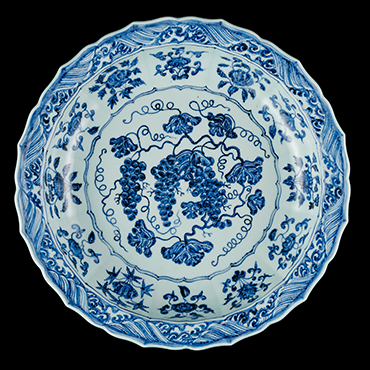Chinese dish prized by a Persian princess and an Indian emperor
Some of the finest blue-and-white ceramics ever made were produced by the imperial Chinese kilns at Jingdezhen, under the Ming Dynasty (AH 769–1053/1368–1644 CE) and, in particular, during the reign of the Yongle emperor (r. AH 805–28/1403–25 CE). Many were traded or sent as diplomatic gifts to rulers in the Islamic world. Among these were superb dishes which always feature a single stem with three bunches of grapes. Such ceramics were a source of lasting inspiration to Ottoman and Safavid ceramicists and were also treasured at the Mughal court. Eleven Ming dishes of exactly this type were collected as part of the Safavid dynastic collection, while other examples are known from the Topkapi Palace in Istanbul.
The inscriptions on the back of this dish document its provenance. The earliest of these reveals that it belonged to the Safavid princess Mahin Banu Begum (AH 925–69/1519–62 CE), the sister of the Persian ruler Shah Tahmasp (r. AH 930–84/1524–76 CE). The Princess was a learned individual and skilled calligrapher in her own right, whose advice was sought by her brother. After her death, most of her collections of jewelry and Chinese porcelain were donated. Almost a century later, this dish was acquired by the Mughal emperor Shah Jahan (r. AH 1037–68/1628–58 CE), as is evident from another inscription on the base of the dish that carries his name with the date AH 1053/1643–4 CE.
The Mahin Banu dish
Jingdezhen, China, AH 805–28/1403–25 CE
Chinese inscription, AH 1148-1210/1735-1799 CE
Glazed porcelain, diam. 43.2 cm
The Al Thani Collection ATC607

